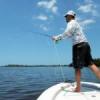Search the Community
Showing results for tags 'damsel'.
Found 3 results
-
Hovering Damselfly An attractor pattern based on the common-blue damselfly and designed to suspend itself just above the water surface like seen in a hovering common-blue damselfly -- instead of floating in the film, like a spent fly design, as many dry-fly damselfly patterns are designed to do. The fly details are blurred by being suspended above the water surface, that feature along with the long-thin bright blue body, give the impression of a hovering damselfly that triggers a strong-bite response from fish. The fore and aft dry-fly style is designed to be a high-riding pattern that can float a beaded nymph on a dropper. The pattern is effective fished as a dry fly on moving and still waters as well as fished wet with a slow retrieve like a wooly bugger. Catskill style design is designed to be fished with a light touch on a single fly rig with long light tippets over skittish fish. Recipe Hook: Regular length dry fly hook, around size 8 Thread: Ultra 140 denier in Peacock Blue Body: 1.5mm to 2 mm thick foam in Damsel Blue color cut into 2 mm wide strips Palmered Hackle: Extra-long dry-fly quality genetic saddle patch in grizzly color select feather to be about 1.5 to 2 times the hook gap width. Variants: Tied both in a fore and aft dry-fly style and a Catskill dry-fly style Common Color variants: most have a dark bands spaced across the abdomen and vary from medium-brown to reddish brown to red, black, ginger and yellow olive. Tying and Fishing Notes 1. The palmered grizzly hackle keeps the fly suspended above the water surface and is designed to suggest the blur of transparent wings of a hovering damsel fly. The spiral of palmered grizzly hackle laid down on the blue foam body suggests the dark and light banding of the natural’s extended body. The palmered variant is designed to be more buoyant that the Catskill style so it can support a dropper fly tied on the hook bend. 2. The palmered hackle when treated with floatant and combined in this design with the foam body, makes this a high-floating bright-blue attractor pattern that is capable of supporting a beaded nymph dropper, preferably tied in at the hook bend, as part of a dry-dropper two-fly rig. 3. Also effective is a variant tied with the foam secured with thread just behind the hook eye along with several turns of grizzly hackle also just behind the hook eye in the Catskill dry-fly style and the free floating foam body extending out from there. Optional: add a few thin bands of color spaced at 3mm interval along the extended portion of the foam strip using a brown or black sharpie marker. 4. A high-riding pattern designed to float beaded nymph droppers. Effective fished as a dry fly on moving and still waters as well as fished wet with a slow retrieve like a wooly bugger 4. Using 2-3mm cylinders of sky blue or electric blue closed cell foam is also an option for this fly but are more costly. 5. The palmered feather cushioned from the fish bite by the foam body seems to be more durable and less prone to breakage than expected. 6. Long-reach whip finish tool makes it easier to tie a whip finish at the hook bend.
- 23 replies
-
- dryfly damselfly
- damselfly
- (and 7 more)
-
hey I had an idea of a fly thats basically a slim mylar tube body and tail but i added two rubber legs at the head o was first thinking it might mimmick a salamander but when i looked closer at the finished product i snipped the legs quite short it looked like a minnow of some sort. by buddy says it looks like a disco dasmel which he called it when i did it with a blue deer hair.
-
Posted a picture of this in the "February Flies" topic but figured Id do some shameless self promotion and post it here and include another photo. Enjoy.
